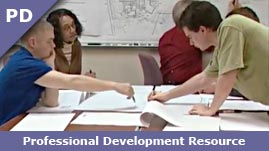Teachers' Domain - Digital Media for the Classroom and Professional Development
User: Preview

Source: Making Learning Real: "Jack Wallace's Classroom"
This media asset is from Making Learning Real: "Jack Wallace's Classroom."
In this video from Making Learning Real, an architectural design class uses the Problem-Based Case Learning (PBCL) approach. Students have been asked to design a wellness center for their college. The college’s building committee is the business partner. In response to feedback from the building committee—all the student designs were rejected—students are taking stock of their approaches and revising their plans. As part of this work, they use a PBCL tool, the Need to Know Board, to identify what they know and what they need to learn.
With PBCL, students work to solve a real-world problem from a business partner. The instructor sets the context for the problem and facilitates the learning process. The real-world problem becomes the heart of the curriculum, as the class works through a problem-solving cycle that includes stages for framing the problem, developing and testing responses, revising and refining based on feedback, and, ultimately, presenting solutions to the business partner.
In the workplace, proposed solutions to a problem may not succeed. Through PBCL, students can discover how to respond to critiques, learn from unsuccessful paths, and build better solutions. PBCL provides a framework for revising and refining ideas based on feedback. Students analyze the shortcomings of their approaches, and work to create improved solutions.
In this video, the students work through the “Test Points” stage of the PBCL Cycle. At this stage, students refine and present solutions to fellow students and the instructor. The Need to Know Board (NTKB) is a practical tool for this stage, as it helps students identify what they already know, and what information is required to move forward.
 Loading Standards
Loading Standards